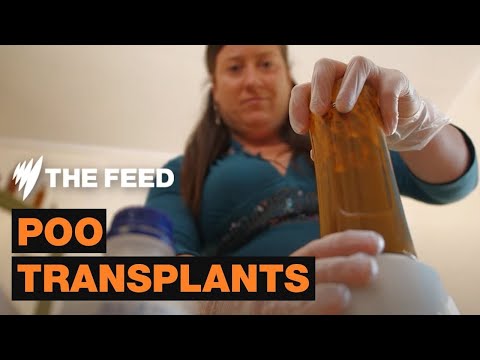The problem with fecal transplants – and the reason they are banned everywhere except France unless you have incurable c. difficile colitis, is that there are 100 million organisms in poop and you never know what you are getting in addition to the target organism. There was a reported case of a woman who was given fecal transplant for c. difficile who became morbidly obese. When doctors checked, the fecal donor turned out to be obese. It’s well known that gut bacteria can cause obesity.
Good to know… seems like an area that should get more research investment to identify the helpful organisms and develop a safe service for broader testing and implementation…
Anybody know where I can get some young mouse poop?
Given the internal microbiome starts in the mouth, I wonder if asking your young children/grandchildren to put the fork or spoon that you are about to use into their mouths first thus depositing a small bit of their oral microbiome for one to ingest.
I have no idea if any of the oral microbiome would make it through the stomach, but it would certainly be less messy than trying to go for the other end of the body!
Is it worth trying?
Any thoughts anyone?
There’s a lot of people doing diy fecal transplants. Using a healthy relative donor. There’s been some really good papers on the subject lately. Yale did one a while back, and it discusses it healing all kinds of diseases, including cancers. There’s a lady on YouTube who does them, and show most of the process.
Could you pls post a link to that video on YT? Thanx
For those interested. This is where you can purchase healthy “crapsules” a word I pray finds its way into the dictionary.
I would caution that while this shows immense promise, we’re just at the beginning of unpacking the complexity of the human gut biome. There is some evidence to suggest that mental illness and obesity can be affected by specific gut microbes, we just don’t know enough yet, so you need to weigh up those risks.
Digestive enzymes have an effect on the diversity of the microbiome, so PERT can be an effective tool to support a healthy microbiome. Think about it
Bacteria from those who already survived to old age may also also be a viable approach. No need to transplant grandma’s poop. Korean scientists have determined what is abundant in centenarian guts.
The relative abundance of Firmicutes was found to be considerably higher in subjects from longevity villages than those from urbanized towns, whereas Bacteroidetes was lower. Age-related rearrangement of gut microbiota was observed in centenarians, such as reduced proportions of Faecalibacterium and Prevotella , and increased proportion of Escherichia , along with higher abundances of Akkermansia , Clostridium , Collinsella , and uncultured Christensenellaceae . Gut microbiota of centenarians in rehabilitation hospital were also different to those residing at home. These differences could be due to differences in diet patterns and living environments. In addition, phosphatidylinositol signaling system, glycosphingolipid biosynthesis, and various types of N-glycan biosynthesis were predicted to be higher in the gut microbiota of centenarians (corrected p < 0.05).
Full paper below.
https://www.jmb.or.kr/journal/view.html?doi=10.4014/jmb.1811.11023
The paper reveals what the centenarians eat.
Table. 1. Table 1
Dietary characteristics of each group.
| Centenarians | Elderly | Adult | p value | |
|---|---|---|---|---|
| Subjects (n) | 25 | 13 | 9 | |
| Number of meals (per day) | 2.84 ± 0.37 | 3.00 ± 0.00 | 2.33 ± 0.50 | <0.001 |
| Number of snacks (per day) | 1.06 ± 0.82 | 1.69 ± 0.85 | 0.50 ± 0.61 | 0.004 |
| — | ||||
| Frequency of intake (per month) | Centenarians | Elderly | Adult | p value |
| — | ||||
| Subjects (n) | 22 | 12 | 9 | |
| Meat | 13.5 ± 22.7 | 10.8 ± 12.1 | 16.4 ± 13.0 | 0.787 |
| Eggs | 8.1 ± 8.3 | 6.7 ± 5.7 | 17.7 ± 13.3 | 0.015 |
| Fish | 8.8 ± 9.7 | 8.6 ± 10.6 | 5.0 ±2.5 | 0.536 |
| Bean curd | 12.7 ± 12.9 | 19.1 ± 25.0 | 9.0 ±5.8 | 0.354 |
| Fermented soybean pastes | 28.6 ± 27.1 | 35.8 ± 28.2 | 9.8 ± 5.4 | 0.061 |
| Dairy products | 6.2 ± 9.3 | 9.2 ± 12.8 | 4.3 ± 3.9 | 0.510 |
| Fruits | 12.7 ± 13.2 | 20.4 ± 20.2 | 21.7 ±14.5 | 0.237 |
| Eat protein | 43.1 ± 37.3 | 45.1 ±25.8 | 48.1 ±26.7 | 0.925 |
Looks like a lot of tofu and miso there. They’re not vegan.
I have to say that digestive enzymes are the only supplement that has ever made a real difference for me and I wish that I had started taking them sooner. Mine also have pre- and probiotics. Not sure if I really need the pre- and pro- or if they are truly helpful or harmful in that they might possibly reduce genetic diversity but for now they work great.
My food is all plants with some modest quantities of fish-based supplements, very high in fiber, low but not zero in overt starches. I get about 50-65 g/fiber day with my 1500 daily kcals.
And the reverse is true - old microbiome accelerates aging in young mice…
Fecal Microbiota Transplant from Old to Young Mice Produces Vascular Aging and Metabolic Dysfunction
Here are two interesting points about the gut microbiome that have become clear in recent years: (a) the composition of the gut microbiome, the relative sizes of microbial populations, changes with age in ways that contribute to inflammation and tissue dysfunction throughout the body; and (b) it is possible to produce lasting change in the composition of the gut microbiome through either engineering of an immune response against target microbes or the procedure of fecal microbiota transplantation from a donor with a very different microbiome.
A simple example of the immune engineering approach is to inject small amounts of flagellin, the protein making up bacterial flagellae, to rouse the immune system into greater efforts to destroy anything it can find equipped with a flagellum. In the gut, most such bacteria are undesirable. Like fecal microbiota transplantation from a younger donor, the effects are unknowable in advance, generally in the direction of producing benefit, but these are not precision approaches to therapy. One can’t yet engineer the exact gut microbiome one desires. Unfortunately strategies involving oral probiotics, which seem the most obvious path towards obtaining more of the specific microbes desired in the gut, have yet to advance to the point at which they are capable of producing lasting change; their effects are very transient.
As today’s open access paper illustrates, the aged gut microbiome is clearly harmful. It is harmful in ways that even a young body and immune system cannot escape from. Just as fecal microbiota transplantation from young to old animals produces a lasting change to a young-looking microbiome in an old body and consequent benefits to health, the reverse produces a lasting change to an old-looking microbiome in a young body and consequent damage and dysfunction to tissues throughout the body. This is a good argument for replacement of the microbiome to be the primary thrust of development when it comes to finding ways to remove this aspect of aging. It seems unlikely that rousing the aged immune system is going to solve enough of the problem if a young immune system cannot wrestle an aged gut microbiome into shape.
Aged Gut Microbiome Induces Metabolic Impairment and Hallmarks of Vascular and Intestinal Aging in Young Mice
I’ve done a little research on this in the past. I have had intermittent gut issues since a round of Cipro about 7 years ago.
Definitely one of the things on my list to try, however, I still think it’s really early. If anyone is interested in digging into it, there are some interesting organizations out there.
Is run by Michael Harrop, his organization has sampled over a million donors. From the outside it looks to me as if he needs to partner up with a university or biotech company to scale and make his data useful.
There are also some other interesting people doing FMT clinical trials outside of C. Difficile, which is currently the only indication.
This lab is run by Dr. Hazan, my friend is one of her data scientists and she told me she’s seen some unbelievable results through some of the trials she’s conducting.
So far, she’s only working with specific conditions, but interesting to see where things might be heading.

